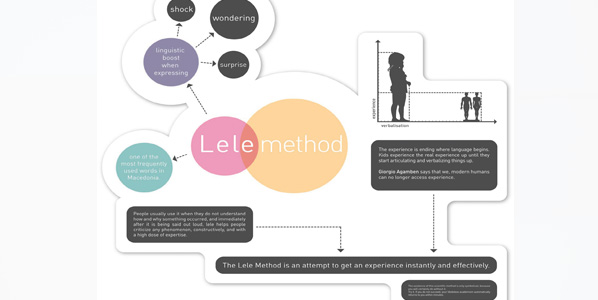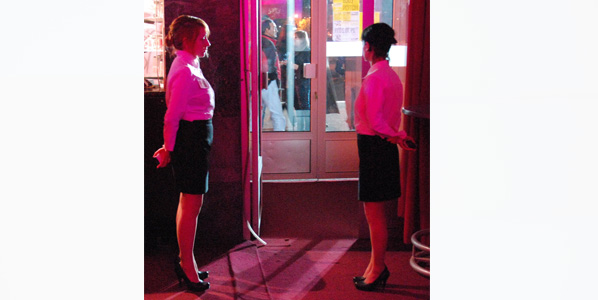



Dragana Zarevska and Jasna Dimitrovska are visual and performing artists, cultural workers and activists from Macedonia, who also, often work together under the artistic pseudonym Ephemerki. While at the same time loving and teasing the rigidity of academism, they like decoding magic, making it transparent, go behind Wizard of Oz’s curtain and put his pants down. The name of the duo is a funny derivate of Bapchorki (band of few grannies who used to sing Macedonian traditional songs in a rustic nasal style). It suggests that Ephemerki are their ephemeral version, or at least, the ones doing the ephemeral part of tradition. Their work is driven from and inspired by Donna Haraway, Judith Butler, Deleuze and Guattari, Agamben, and other contemporary thinkers and practitioners within arts, technology, society.
The Lele method is their latest performance (a performative event for a bunch of people, as they like to call it) and so far was performed at AKTO 6, Festival for Contemporary art in Bitola and Kondenz & Locomotion, Performing arts festivals organized in Skopje and Belgrade. Here is the story behind the project.

Darko Aleksovski: ‘Lele’ (Мac: леле) is a word that has profound significance in the Macedonian language. It is a universal word that can be used in different contexts and can imply several different emotional states. Can you describe what was the inspiration for this project dedicated to the word ‘lele’? What is the subjective meaning of this word for you?
Dragana Zarevska/ Jasna Dimitrovska: The particular situations this word implies and the problems it addresses might sound quite confusing for the non-Macedonian readers, but, if any of them have visited, or will visit our country, it’ll be deadly surprising how many “leles” per minute one hears around. The word “lele” is totally devoid of meaning, but it is being used to emphasize certain emotions, wondering, shock, great happiness and similar. It is just a shout out, like…the French “oh-la-la” for instance, the Bulgarian “ma-leeeh” or like the Serbian “yoooooy”. The project is being titled “The Lele Method”, directly and totally driven from the local obsession with lele and its possible application.
For us, this word sometimes depicts the shortly shaken numbness and the apathy of our current socio-political constellations, but only with a shout, and then again – everything goes on as usual.

Darko Aleksovski: What is the ‘lele method’? Considering the performative act of the ‘lele’ word, and its everyday use in Macedonian speech, do you think that a method like this can still function as relevant? Can the ‘lele method’ be appropriated by anyone, or it is just a method that you as an artist use?
Dragana Zarevska/ Jasna Dimitrovska: Sure. It can be appropriated by anyone, but it is still a joke. You will certainly do without it as a method. Using it will not bring anything to your life what you’ve not had before. This is how we define it: Lele is one of the most frequently used words in Macedonia… people usually use it when they do not understand how and why something occurred, and immediately after it is being said out loud, Lele helps people criticize any phenomenon, constructively, and with a high dose of expertise. Try it. If you do not succeed, your libidoless academism automatically returns to you within minutes.
These instructions can help a lot in experiencing this useless experience through this useless method. But, stating the obvious with The Lele Method is what we enjoy the most. We give people what they already have, like selling snow to Eskimos.
Recently, in an interview we gave for the Canadian .dpi Magazine we discussed some particular effects we achieved by performing Lele. Nobody is aware of performing it daily here in Macedonia, and while we were preparing the performance out of it/about it, we realized the power of defamiliarization. You perform something which is being performed daily in a constant automatization. By naming a method Lele and putting it on a stamp, we gave the word a particular relevance and a different form. We made it “unfamiliar” and “difficult”, and by that, we prolonged the process of perception of that word. By trying to remove the automatism of perception, we got a new perspective of a word, of a problem. This technique has been used in the literary criticism of Russian formalism to differentiate prose from poetry, but we use it to differentiate and to delay perception. As Russian formalist critic Viktor Borisovich Shklovski has said in his well-known essay “Art as Device,” – the purpose of art is to impart the sensation of things as they are perceived and not as they are known.

Darko Aleksovski: You have presented this project two times so far – as a performance accompanied by the printed version of the scheme of the ‘lele method’. How much performance is a necessary medium for this project?
Dragana Zarevska/ Jasna Dimitrovska: We’ve shown the performance at this year’s Akto Festival for Contemporary Art during August (Bitola/Macedonia), and at the Kondenz & Locomotion curatorially joint festivals for performing arts organized in Skopje and Belgrade during October. We must admit we entertain ourselves a lot during the performance because people enter the room and they perceive it as some irrelevant and boring employees who put a stamp on everyone’s hand at the venue’s door. Then, they look at the stamped hand/arm and shout “Leeeeeh-leeeeeh!” because that’s being engraved on our stamps.
During the performance we are dressed in our Lele uniforms which are extremely office-like and conservative, our faces are shit-serious, and inside the room there are printed materials (scattered leaflets on the tables, or printed panels on the wall) with diagrams on them explaining the empirical part of the Lele Method. The concept behind the Lele Method is being driven by our love and respect towards Giorgio Agamben’s work and his ideas on experience shown in his work Infancy and History. The experience is ending where language begins. Kids have the real experience until they start articulating and verbalizing things up. Giorgio Agamben says that we, modern humans can no longer access experience. The Lele Method is an attempt to get an experience instantly and effectively. The existence of this scientific method is only symbolic, because it is just mocking the academia and the naive ones simultaneously, as – all of the work we did/do by far.
Much of this performance auto-perpetuated, it is happening by itself. Performance is always a necessity. It is better for us to be aware of it, because we all perform all the time. This performance is all about being aware that we perform something of which we usually forget, but is actually performable – something automatized like the word Lele.
Darko Aleksovski: The project was very well received by the audience, other artists and critics. Does it have another aspect of it, that is directed as a critique towards the whole Macedonian art system?
Dragana Zarevska/ Jasna Dimitrovska: Thank you for this notion. Actually it was fantastic how great it was received. Our work can often be seen as an overlap between theory, movement, process and production. The contextualization of these things shapes the performative events we present that test and deconstruct different versions of reality and its geography, directly related to awareness of the possibilities of language. We criticize language/es through language.
Darko Aleksovski: Do you see ‘lele’ differently, now that you have made a project out of it?
Dragana Zarevska/ Jasna Dimitrovska: Yes we do. We got de-familiarized with it (by getting hiper-familiarized), while, at the same time we started to think of it as of our own word, which is pretty selfish. We totally “adopted” it. Other people who came to our performances also tell us they experience it a bit differently than before, one friend said “Whenever I say Lele I think of you!”. We know this might sound weird and vain, but it seems we assimilated it as our own piece of art, and the truth is – it is so not ours, it is everyone’s. We surely assimilated the illusion of having it as ours though.
more about the artists: zarevska [at] gmail.com, yasna.dimitrovska [at] gmail.com